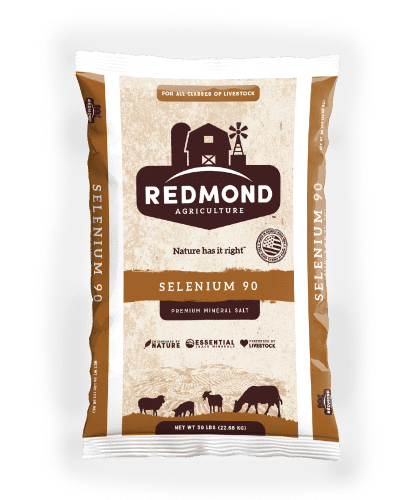The sea salt contains added selenium necessary for animals that require a high level of selenium. This is the same as the Selenium 30 except that we boost the  Selenium all the way to 90 ppm Selenium.
Selenium all the way to 90 ppm Selenium.
The salt deposit that exists in Redmond, Utah, is an inland deposit of ancient origin. It is one of the world’s richest and most perfectly balanced salt deposits, containing over 60 trace minerals from the periodic table of elements. It is mined and crushed for packaging, without any of the refining processes. So what’s left for us is pure, unaltered sea salt and minerals that are balanced in a proportion–nature’s way.
In this balance of minerals, the salts in the Redmond deposit consist of around 93% sodium and chloride; the remaining 7% are the other minerals. It is of no coincidence that our blood serum has the same concentrations! That is significant! Is it any wonder people feel better when they use natural sea salt? Is it any wonder that animals and plants are healthier when they utilize natural minerals? The mineral salt that comes from the Redmond mine is in the form nature intended for ingestion. The body does not easily recognize refined products, causing it stress as it tries to work with something unnatural. It is important to note that these natural salts are crystalline in form. They are highly available to the body. Most minerals are in rock form and are poorly utilized. The chelation process improves this but the crystalline form trumps.
Sold in 50lb bags and in bulk.
Benefits:
When Redmond mineral products are offered, particularly Redmond Salt, beef cows don’t eat white salt and normally cut back their consumption of custom minerals. This becomes quite a cost savings just from the standpoint of mineral costs, let alone the increased health benefits. These are the reports we repeatedly hear:
Cows consume less custom mineral
They breed back better
Less foot rot and pinkeye
Less grass tetany
Healthier looking hair coats
Reports from other livestock classes are similar whether it’s horses, dairy goats, sheep, or even poultry. Animals simply eat and perform better with less health challenges when they have access to Redmond mineral products.
The same benefits on the field are much the same as in livestock. Many think “why would I use Redmond Salt on my field?” What is interesting is how much goes on with the use of chemical fertilizers. Lots of potassium chloride is used. Many Midwestern and eastern farms that have not used chemical fertilizers for a few years find that their soils need more sodium and chloride. But the magic is in the trace minerals. When the salts and traces are together in nature’s balance, good things happen, and the same synergy that makes a healthy gut and digestion works in the soil too. The other thing is that it doesn’t take much of the salt to get the benefit. When anywhere from 20 to 200 lbs. per acre is used in dry applications, it’s just enough to enhance energy and microbial activity and not even close to enough to be overwhelming. Foliar applications are only 3 or 4 lbs. per acre because of direct application to the plants. But spoon-feeding plants this way requires repeated applications.
How to Feed:
Feed free choice and added to your animal’s ration year round. Provide plenty of fresh, clean water at all times.
Ingredients/Guaranteed Analysis:
Calcium (minimum) 0.35%
Calcium (maximum) 0.85%
Phosphorous (minimum) 0.02%
Salt (minimum) 88.0%
Salt (maximum) 93.0%
Magnesium (minimum) 0.06%
Potassium (minimum) 0.03%
Sulphur (minimum) 0.07%
Zinc (minimum) 3500 ppm
Manganese (minimum) 2000 ppm
Iron (minimum) 600 ppm
Copper (minimum) 300 ppm
Iodine (minimum) 110 ppm
Cobalt (minimum) 50 ppm
Selenium (minimum) 90 ppm
Ingredient Statement:
Salt (Mineral Sea Salt), Sodium Selenite, Zinc Oxide, Zinc Sulfate, Manganous Oxide, Manganous Sulfate, Copper Sulfate, Cobalt Carbonate, Ethylenediamine Dihydriodide (EDDI).
Brochure:
Redmond Product Directory

